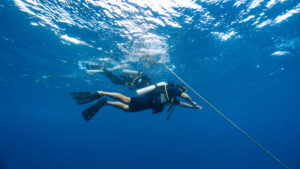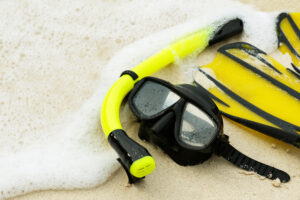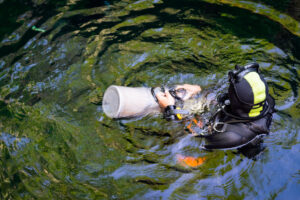What is the purpose of Fins in Scuba diving, Freediving, and Snorkeling?
Fins, a crucial piece of scuba diving equipment, are designed to improve a diver’s propulsion and maneuverability underwater. They are worn on the feet and help divers swim faster and with less effort, conserving energy and making diving a more enjoyable experience. This entry will explore the history, types, materials, and selection of fins for scuba diving, as well as tips for efficient finning techniques.
History of Fins
The concept of fins dates back to ancient times, with early divers using palm fronds or animal skins wrapped around their feet to enhance their swimming capabilities. However, the modern version of fins was first patented in 1933 by Frenchman Louis de Corlieu. His invention, the “swimming propeller,” paved the way for the development of various fin designs and materials throughout the 20th and 21st centuries.
Types of Fins
Full-foot Fins
These fins feature a closed heel and are designed to be worn without dive boots. They are generally lighter and more flexible than open-heel fins, making them ideal for warm water and low-stress diving environments.
Open-heel Fins
Featuring an adjustable strap that fits around the heel, these fins are designed to be worn with dive boots. They provide a better fit and more support than full-foot fins and are suitable for cold-water diving and more demanding conditions.
Split Fins
Characterized by a split down the center of the fin blade, split fins are designed to reduce drag and increase propulsion efficiency. They work by channeling water through the split, generating thrust with less effort than traditional paddle fins.
Paddle Fins
These fins feature a single, solid blade that provides maximum thrust with each kick. Paddle fins are versatile and well-suited for a variety of diving conditions but may require more effort to use compared to split fins.
Materials
Fins are commonly made from one or a combination of the following materials:
Rubber
Highly durable and flexible, rubber fins have been in use since the early days of scuba diving. They provide excellent propulsion and are resistant to wear and tear, but they can be heavier than other materials.
Plastic
Lightweight and affordable, plastic fins are a popular choice for recreational divers. They offer a good balance between durability and flexibility but may become brittle over time.
Silicone
Known for its flexibility and comfort, silicone fins are often used in the construction of full-foot fins. They provide efficient propulsion but may wear out faster than rubber or plastic fins.
Composite materials
Fins made from a combination of materials, such as plastic and rubber or plastic and fiberglass, offer a balance of flexibility, durability, and weight. These fins often feature advanced designs for improved efficiency and performance.
Selecting the Right Fins
When choosing fins, divers should consider factors such as fit, comfort, efficiency, and their specific diving needs. Here are some tips to help you select the right fins:
- Determine the type of diving you will be doing. Cold-water diving, technical diving, or challenging conditions may require the support and adjustability of open-heel fins, while warm-water diving or snorkeling may be better suited for full-foot fins.
- Try on multiple sizes and styles to find the best fit. Fins should fit snugly without causing discomfort or restricting circulation.
- Consider your physical fitness and kicking style. Split fins may be more suitable for those with limited leg strength, while paddle fins may be better for strong swimmers or those who prefer a more powerful kick.
- Test your fins in the water to assess their performance and comfort during actual diving conditions.
Efficient Finning Techniques
Proper finning techniques not only enhance your diving experience but also conserve air, energy, and reduce the risk of injury. Here are some common finning techniques to help you maximize efficiency and comfort underwater:
Flutter Kick
The most widely used finning technique, the flutter kick involves alternating up and down movements of the legs, similar to a freestyle swimming kick. This technique generates propulsion with each kick and is effective in various diving conditions. To maximize efficiency, focus on long, smooth strokes rather than short, rapid kicks.
Frog Kick
Inspired by the leg movement of a swimming frog, this technique involves bending the knees and bringing the heels close to the body before pushing the fins outward and then back together in a circular motion. The frog kick is well-suited for tight spaces and environments with delicate marine life, as it generates less water disturbance and helps maintain better control and buoyancy.
Dolphin Kick
In this technique, both legs move simultaneously in an undulating motion, resembling the swimming style of a dolphin. This finning style is particularly efficient when using a monofin but can also be adapted to regular fins. The dolphin kick requires strong core muscles and may be more challenging for inexperienced divers.
Modified Flutter Kick
Similar to the standard flutter kick, the modified flutter kick involves a more relaxed, bent-knee motion that generates propulsion primarily from the ankle and lower leg. This technique can reduce stress on the knees and hips, making it a good option for divers with joint concerns.
Caring for Your Fins
Proper care and maintenance can extend the life of your fins and ensure their optimal performance. Follow these tips to keep your fins in excellent condition:
- Rinse your fins thoroughly with fresh water after each dive to remove salt, chlorine, and debris that may cause damage or wear.
- Store your fins in a cool, dry place away from direct sunlight to prevent warping or degradation of the materials.
- Check your fins regularly for signs of wear, such as cracks or tears in the blades, and replace them as necessary to maintain optimal performance.
- For open-heel fins, inspect the straps and buckles for wear or damage and replace them when needed.
Fins are an essential component of scuba diving gear, designed to improve a diver’s propulsion and maneuverability underwater. By understanding the different types, materials, and finning techniques, divers can choose the right fins to match their specific needs and diving conditions, ensuring a more enjoyable and efficient diving experience. Proper care and maintenance of fins will ensure their longevity and optimal performance, making them a valuable investment for any scuba diver.

















